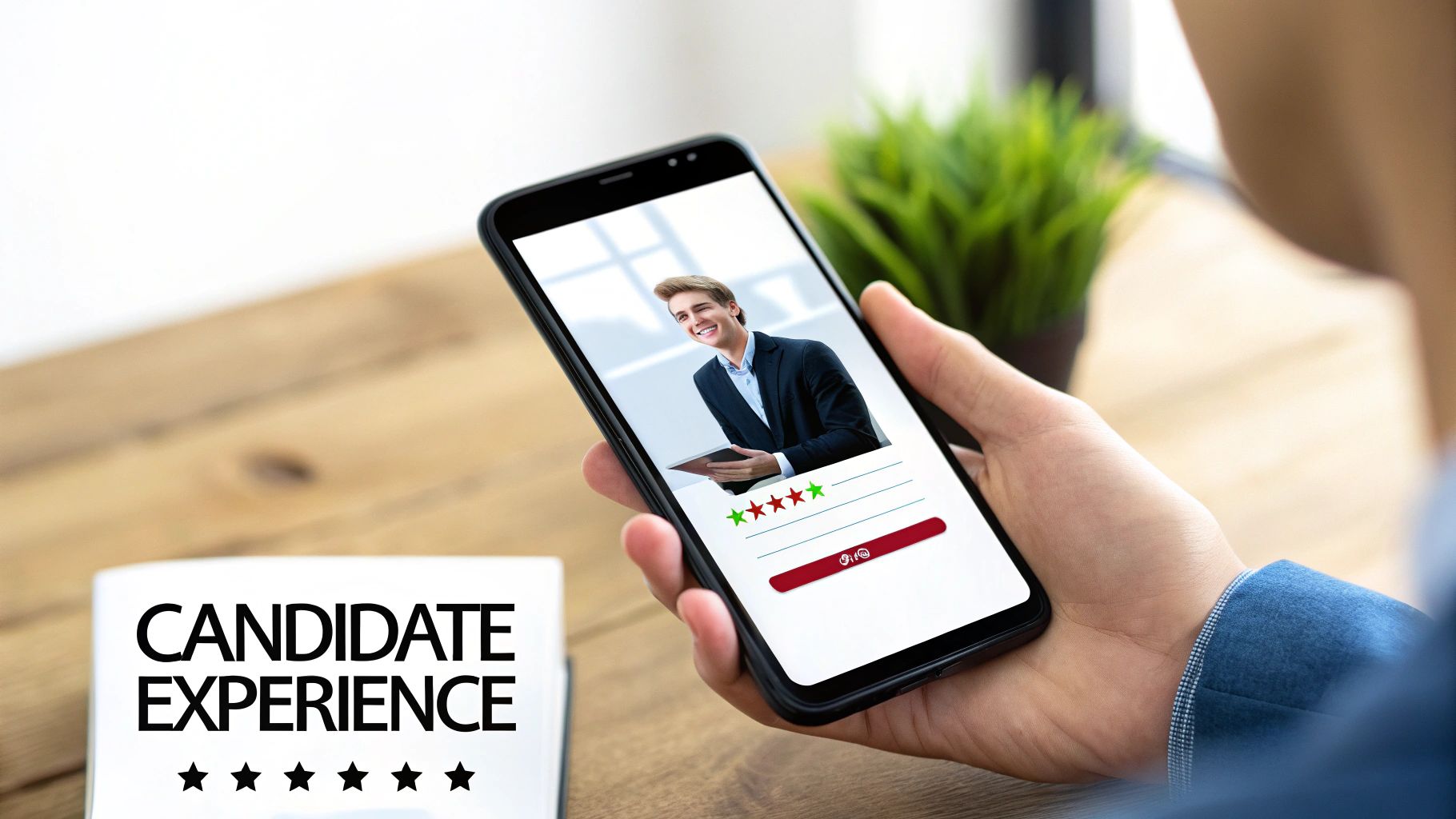In today’s fiercely competitive talent market, attracting premier professionals demands more than just a well-crafted job posting. The protracted battle for talent is no longer won by outreach alone, but through meaningful connection and a demonstrably superior candidate experience. For Chief Human Resources Officers (CHROs) and leaders in Recruitment Process Outsourcing (RPO), mastering candidate engagement strategies is no longer a peripheral activity; it has become the central pillar of any successful hiring framework. A disengaged candidate represents a significant lost opportunity, one that negatively impacts not just a single role but the long-term perception of your employer brand.
This comprehensive guide moves beyond generic advice to provide ten specific, actionable strategies designed to transform your recruitment process. We will shift the focus from a simple transaction to the cultivation of a lasting professional relationship. You will discover how to build authentic connections that not only fill critical roles faster but also attract candidates who are genuinely aligned with your organisation’s culture and long-term strategic vision.
Within this article, we will delve into the practical tactics that will define successful talent acquisition for the foreseeable future, covering everything from personalised communication and talent relationship management to data-driven optimisation and creating immersive recruitment events. Prepare to explore the candidate engagement strategies that will give your organisation a decisive competitive edge.
1. Personalized Communication and Outreach
In an era of automated, high-volume recruitment, personalised communication stands out as a powerful differentiator. This strategy involves moving beyond generic templates and tailoring outreach to each candidate’s unique profile, skills, and career aspirations. By demonstrating genuine interest and a thorough understanding of their professional background, you transform a cold outreach into a warm, compelling conversation, making it one of the most effective candidate engagement strategies available today.
This approach centres on creating a meaningful one-on-one connection. It shows the candidate that they are not just another number in a database, but a valued professional whose specific expertise has been recognised and is being actively sought. The goal is to make the individual feel seen, understood, and truly wanted for the unique value they can bring to your organisation.

Why It Works
Personalisation significantly boosts response rates and builds a positive employer brand perception from the very first interaction. When candidates receive a message that references their specific projects, recent accomplishments, or shared professional connections, it immediately signals that your organisation is thoughtful, diligent, and serious about finding the right talent. This initial positive experience can influence their decision-making process throughout the entire recruitment journey.
Key Insight: Personalised outreach isn’t just about using a candidate’s name. It’s about proving you’ve done your homework and can articulate precisely why they are a great fit for this specific role and your company culture.
How to Implement It Effectively
- Deep-Dive Research: Utilise ATS data, LinkedIn profiles, and professional portfolios to gather specific details. Look for recent project launches, published articles, or specific technologies they have mastered.
- Reference Specific Accomplishments: Instead of a generic “I was impressed with your profile,” try “Your work on the Project Phoenix launch, particularly the front-end architecture you developed, is exactly the kind of expertise we need for our new fintech platform.”
- Use Personalised Video: A short, 60-second video message from the hiring manager or a senior team member can have a massive impact. This humanises the process and demonstrates a high level of commitment.
- Align with Their Values: If a candidate’s profile highlights an interest in sustainability or community work, connect that to your company’s CSR initiatives. This shows a cultural alignment beyond just skills.
2. Employee Referral Programs
Leveraging current employees as brand ambassadors to tap into their professional networks is one of the most powerful and trusted recruitment channels. This strategy turns your entire workforce into an extension of your talent acquisition team, where they can authentically vouch for your company culture and the specific role. By encouraging referrals, you access a pre-vetted pool of candidates who often come with a built-in understanding of your organisation’s values, making it a cornerstone of effective candidate engagement strategies.
This approach is built on the foundation of trust and credibility. A recommendation from a current employee carries significantly more weight than a cold call from a recruiter, as candidates trust the inside perspective of their peers. The goal is to systematise this word-of-mouth marketing, creating a pipeline of high-quality talent that is more likely to be a strong cultural fit and have a longer tenure.

Why It Works
Employee referral programs consistently yield candidates with higher retention rates and a faster time-to-hire. Referred candidates are often more engaged from the outset because they have a personal connection to the company and a clearer picture of the work environment. This pre-existing relationship helps build rapport quickly, reducing uncertainty and accelerating their integration into the team, as seen in the successful programmes at companies like Google and Salesforce.
Key Insight: An employee referral is more than just a CV submission; it’s a personal endorsement. It signals that a trusted member of your team believes the candidate possesses both the skills and the right character to succeed in your organisation.
How to Implement It Effectively
- Simplify the Process: Make submitting a referral effortless. Implement a one-click system through your HRIS or a dedicated platform where employees can easily share job links and upload candidate details.
- Equip Your Ambassadors: Provide employees with clear, concise job descriptions, key selling points about the role, and a compelling “elevator pitch” for the company. Ensure they know exactly what makes a candidate a great fit.
- Offer Meaningful Incentives: Implement tiered bonuses, offering higher rewards for hard-to-fill or critical roles. Consider non-monetary rewards as well, such as extra holiday days or public recognition.
- Maintain Communication: Keep the referring employee updated on their candidate’s progress. A simple notification that their referral has been interviewed or is moving to the next stage keeps them engaged and motivated to refer again.
3. Employer Branding and Thought Leadership
Beyond individual outreach, a powerful employer brand acts as a constant, passive magnet for top talent. This strategy focuses on shaping the public perception of your organisation as a premier place to work. It involves proactively showcasing your company culture, values, and thought leadership to attract candidates who are not just skilled, but also culturally and mission-aligned. By building a compelling narrative, you make your company an employer of choice, turning recruitment into an inbound-driven activity.
This approach is about creating an authentic identity that resonates with the professionals you want to hire. It answers the crucial question: “Why should someone choose to build their career here?” A strong employer brand ensures that when a candidate thinks of the best places to work in their industry, your organisation is at the top of the list. This is one of the most strategic, long-term candidate engagement strategies for sustainable talent acquisition.
Why It Works
A well-defined employer brand significantly reduces time-to-hire and cost-per-hire by creating a pipeline of engaged, inbound candidates. It provides a clear Employer Value Proposition (EVP) that sets you apart from competitors, attracting professionals like Salesforce does with its ‘Equality’ positioning. When candidates already have a positive perception of your organisation’s culture and vision, the recruitment process becomes less about selling and more about finding the right mutual fit.
Key Insight: Your employer brand already exists, whether you manage it or not. Proactively shaping it through authentic storytelling and thought leadership allows you to control the narrative and attract talent that will thrive in your environment.
How to Implement It Effectively
- Showcase Authentic Culture: Use video testimonials, “day-in-the-life” content, and employee-led blog posts to provide a genuine window into your work environment. Buffer’s radical transparency is a prime example of this in action.
- Promote Executive Thought Leadership: Position your leaders as industry visionaries. When executives share insights at conferences, on podcasts, or through articles, it elevates the entire organisation’s reputation.
- Leverage Employee Advocacy: Encourage your team to share their positive experiences and professional achievements on platforms like LinkedIn. Their authentic voices are more powerful than any corporate messaging.
- Maintain Brand Consistency: Ensure your EVP is consistent across your career site, job descriptions, social media, and review sites like Glassdoor. For more guidance, you can explore how to scale your employer branding with online recruitment events.
4. Candidate Experience Optimization
Candidate experience optimisation is the process of strategically improving every interaction a potential employee has with your organisation, from their first point of contact to their final hiring decision. This approach treats the recruitment journey itself as a crucial marketing and branding opportunity, recognising that a seamless, respectful, and efficient process can significantly boost offer acceptance rates and fortify your employer brand. It is one of the most fundamental candidate engagement strategies for building long-term talent pipelines.
This strategy centres on removing friction and adding value at every stage. It ensures candidates feel informed, valued, and respected, regardless of the hiring outcome. By prioritising their journey, you demonstrate your company’s professionalism, culture, and commitment to its people, leaving a lasting positive impression that can influence future applications and referrals.

Why It Works
A superior candidate experience directly correlates with higher engagement, lower dropout rates, and a stronger employer reputation. Companies like Hilton, which reduced application time by 75% with a mobile-first platform, prove that ease and efficiency are highly valued. When candidates have a positive experience, they are more likely to accept an offer, reapply for future roles, and recommend your organisation to their network, turning every applicant into a potential brand ambassador.
Key Insight: The candidate experience is not just an HR function; it is a direct reflection of your company’s values. A negative process suggests a disorganised or indifferent culture, while a positive one signals a supportive and employee-centric environment.
How to Implement It Effectively
- Audit Your Application Process: Meticulously map out and time every step of your current application. Identify and eliminate redundant questions or unnecessary stages. Aim for a process like Amazon’s one-click apply system where possible.
- Automate and Communicate: Implement automated emails to instantly acknowledge an application. Provide candidates with regular, transparent status updates throughout the process so they are never left wondering about their standing.
- Equip Candidates for Success: Create and share interview preparation guides with sample questions, information about the interviewers, and details on what to expect. This demonstrates a commitment to their success.
- Gather Continuous Feedback: Use short surveys after key stages (application, interview, offer) to identify friction points and areas for improvement. This data is invaluable for iterative optimisation. A well-managed process is also a key factor when you want to reduce the candidate offer dropout rate.
5. Social Media and Digital Community Engagement
In today’s digitally connected world, your next top hire is likely scrolling through a social media feed right now. Social media and digital community engagement involves leveraging platforms like LinkedIn, Twitter/X, and even Instagram to build relationships with talent long before a job opening exists. This strategy transforms recruitment from a transactional process into an ongoing conversation, establishing your organisation as a visible and trusted employer within key professional networks.
This approach is about more than just posting job advertisements. It focuses on creating and sharing value-driven content that showcases your company culture, highlights employee achievements, and contributes to industry-specific discussions. By actively participating in digital communities where your ideal candidates gather, you build brand affinity and a pipeline of warm, engaged talent, making this one of the most proactive candidate engagement strategies for long-term success.
Why It Works
Engaging with candidates on social media humanises your employer brand and provides an authentic, unpolished glimpse into your company’s culture. It allows you to meet talent where they are, building familiarity and trust over time. When a role does become available, you are not a cold, unfamiliar entity but a recognised name that has already provided value, significantly increasing the likelihood of positive engagement and application.
Key Insight: The goal of social media engagement is not just to recruit, but to build a community. When you create a space where professionals want to connect with your brand and its people, you build a sustainable talent magnet.
How to Implement It Effectively
- Share Behind-the-Scenes Content: Utilise Instagram Stories or TikTok videos to showcase a “day in the life” at your company. Feature team outings, project collaborations, or employee spotlights to provide an authentic view of your culture, like Deloitte does with its event highlights.
- Establish Thought Leadership: Encourage leaders and subject matter experts to share industry insights on platforms like LinkedIn. IBM’s extensive thought leadership programme positions its team as experts, attracting talent that values innovation and expertise.
- Leverage Employee Advocacy: Create a programme that encourages and empowers your employees to share company content and their own positive experiences. Microsoft’s employee advocacy programme amplifies its reach into trusted professional networks.
- Engage in Real Conversations: Don’t just broadcast; interact. Respond to comments, participate in relevant industry chats on Twitter/X, and join professional groups on LinkedIn. Actively listen and contribute to conversations to build genuine connections.
6. Talent Relationship Management (TRM) Systems
Proactive recruitment means engaging talent before a role even exists, and Talent Relationship Management (TRM) systems are the technology that makes this possible. A TRM platform functions like a CRM for talent acquisition, enabling organisations to build and nurture long-term relationships with a pipeline of passive and active candidates. By systematically managing these connections, you ensure that when a critical role opens up, you already have a warm, engaged pool of qualified individuals to contact, making it one of the most strategic candidate engagement strategies.
This approach shifts the recruitment mindset from a reactive, transactional process to a continuous, relationship-driven function. Instead of starting from scratch for every vacancy, recruiters can cultivate talent communities, sharing relevant content, company updates, and career advice. This keeps your organisation top-of-mind and positions it as an employer of choice long before a formal application is submitted.
Why It Works
TRM systems dramatically reduce time-to-hire and sourcing costs by providing a ready-made pipeline of vetted, interested candidates. Maintaining ongoing communication ensures that when you do reach out about a specific opportunity, the conversation is a natural continuation of an existing relationship rather than a cold approach. This builds trust and significantly increases the likelihood of a positive response, especially from high-demand, passive talent.
Key Insight: A TRM system transforms your talent database from a static repository into a dynamic ecosystem. It allows you to strategically segment and engage talent based on their skills and career stage, ensuring the right message reaches the right person at the right time.
How to Implement It Effectively
- Create Tiered Nurture Campaigns: Segment your talent pipeline by role, seniority, or engagement level. Develop automated email campaigns with tailored content, such as industry insights for senior leaders or career development tips for early-career professionals.
- Establish Clear Data Governance: Before implementation, define standards for data entry, tagging, and candidate status. Consistent data hygiene is crucial for effective segmentation, scoring, and reporting.
- Use Scoring to Prioritise Outreach: Implement a lead scoring model based on factors like profile completeness, recent engagement, or skill set match. This helps recruiters focus their energy on the most promising and engaged candidates in the pipeline.
- Integrate with Existing Systems: Ensure your TRM integrates seamlessly with your Applicant Tracking System (ATS), email, and calendar platforms. This creates a unified workflow and prevents valuable candidate data from being siloed.
7. Interview Process Transparency and Communication
A lack of clarity in the interview process is a major source of candidate anxiety and a common reason top talent disengages. This strategy focuses on demystifying the hiring journey by proactively communicating the structure, expectations, and decision timelines at every stage. By providing a clear roadmap, you build trust and respect, demonstrating professionalism and creating a positive, low-stress environment for applicants.
This approach transforms the interview from an intimidating test into a collaborative evaluation. It ensures candidates understand what to expect, how to prepare, and when they will hear back, empowering them to perform at their best. As one of the most crucial candidate engagement strategies, it shows that your organisation values a candidate’s time and is committed to a fair and organised process.
Why It Works
Transparency significantly reduces candidate drop-off rates and prevents negative experiences that can damage your employer brand. When candidates feel informed and respected, they are more likely to stay engaged, even if the process is lengthy. This clarity showcases an organised, candidate-centric culture, making your organisation more attractive than competitors who leave applicants in the dark.
Key Insight: Ultimate transparency isn’t just about sending agendas. It’s about explaining the ‘why’ behind each interview stage, helping candidates understand what success looks like and how they are being evaluated against the role’s core competencies.
How to Implement It Effectively
- Create Interview Prep Guides: Develop and share a simple guide outlining the interview format, key topics of discussion, and even sample questions. This helps level the playing field for all applicants.
- Send Detailed Agendas: At least 48 hours before each interview, send an agenda that introduces the interviewers by name and role, specifies the duration, and lists the topics to be covered.
- Communicate Timelines Explicitly: Be upfront about decision timelines. Instead of saying “we’ll be in touch soon,” say “you can expect to hear from our team with an update by Friday.”
- Provide Proactive Status Updates: Even if there is no decision, send a brief weekly update to candidates still in the process. A simple “You are still under consideration, and we expect to have an update next week” goes a long way.
8. Career Development and Growth Path Visibility
Top-tier candidates are not just looking for a job; they are seeking a long-term career trajectory. This strategy involves proactively showcasing the clear, tangible pathways for professional development and advancement within your organisation. By making career growth a central part of your recruitment narrative, you attract ambitious individuals who are motivated by learning, mentorship, and upward mobility, positioning it as one of the most compelling candidate engagement strategies.
This approach shifts the conversation from a single role to a continuous journey of growth. It demonstrates that your company is a place where employees are not stagnant but are actively supported and invested in for the long haul. The goal is to show candidates a future with your organisation, not just a present position, making them feel secure in their choice and excited about their potential.
Why It Works
Highlighting growth opportunities directly addresses a primary motivator for high-achieving professionals. When candidates can visualise their future progression, from their first year to their fifth, it significantly increases their commitment and interest. This transparency builds trust and demonstrates a strong employer value proposition, showing that your organisation invests in its people, which in turn reduces attrition and improves talent quality.
Key Insight: Candidates are evaluating if your opportunity is a stepping stone or a destination. Clearly mapping out career paths, like Salesforce does with its Trailhead platform, proves you are invested in being their long-term career destination.
How to Implement It Effectively
- Create Visual Career Maps: Develop and share clear visual diagrams or frameworks that show typical career progressions for various roles, including timelines and required competencies for advancement.
- Showcase Employee Success Stories: Feature real testimonials and case studies of employees who have grown within the company. For example, highlight a developer who advanced to a Principal Engineer or a marketer who now leads a team.
- Be Transparent About Learning Budgets: Explicitly mention tuition reimbursement programmes, professional certification support, and annual budgets for learning and development in job descriptions and during interviews.
- Integrate Growth into Interviews: Train hiring managers to discuss potential career paths and development opportunities specific to the role. Ask candidates about their long-term aspirations and align them with what your company offers.
9. Interactive and Immersive Recruitment Events
Moving beyond static job descriptions and interviews, interactive recruitment events immerse candidates directly into your company’s environment. This strategy involves hosting dynamic virtual or in-person experiences that allow potential hires to interact with teams, understand the company culture, and tackle real-world challenges. From hackathons and virtual open houses to gamified assessments, these events transform recruitment from a screening process into a memorable, engaging experience, making it one of the most impactful candidate engagement strategies for building a robust talent pipeline.
This approach centres on the principle of “show, don’t tell.” Instead of merely describing your company’s values and work environment, you allow candidates to experience them first-hand. This provides a genuine, two-way assessment where candidates can evaluate if your organisation is the right fit for them, while you observe their skills and cultural alignment in a practical setting.
Why It Works
Immersive events create a strong, positive emotional connection between candidates and your brand. They offer a unique platform to showcase your company’s innovation, collaborative spirit, and commitment to its people. For candidates, especially in competitive fields like technology, these events provide invaluable insight and networking opportunities that a standard interview process cannot match. This often leads to a higher quality of applicants and improved offer acceptance rates.
Key Insight: The most successful recruitment events are not just about filling immediate vacancies. They are designed as long-term talent pipeline builders, creating a community of engaged potential hires who feel a connection to your brand long before a role becomes available.
How to Implement It Effectively
- Offer a Hybrid Approach: Combine virtual and in-person events to maximise reach and accessibility. Use platforms like Hopin or Eventbrite for virtual open houses, while organising localised hackathons or office tours for a high-touch experience.
- Gamify the Experience: Introduce elements of competition and fun to boost engagement. Host live coding challenges, business case competitions like Microsoft’s Imagine Cup, or problem-solving workshops that reflect the day-to-day work.
- Facilitate Authentic Networking: Structure events to encourage meaningful interaction between candidates and current employees from various departments, not just HR. This provides candidates with unfiltered insights into the company culture.
- Create Evergreen Content: Record key sessions, panels, and presentations. Make this content available on-demand for candidates who couldn’t attend live, extending the event’s value and reach.
10. Data-Driven Recruitment Analytics and Optimization
In today’s competitive talent market, intuition alone is no longer sufficient. A data-driven approach transforms recruitment from a reactive function into a strategic, predictive powerhouse. This strategy involves leveraging recruitment analytics to systematically measure, analyse, and optimise every stage of the hiring funnel, ensuring your efforts are not only efficient but also highly effective. By making informed decisions based on hard data, you can significantly enhance your candidate engagement strategies and recruitment ROI.
This method centres on moving beyond gut feelings to understand what truly works. It’s about tracking key performance indicators (KPIs) like source effectiveness, time-to-hire, and quality of hire to pinpoint bottlenecks and identify opportunities for improvement. The goal is to create a continuously learning recruitment engine that adapts to market changes and consistently delivers top-tier talent aligned with organisational goals.
Why It Works
Data-driven recruitment provides unparalleled clarity into your talent acquisition process. It allows you to objectively assess which channels deliver the best candidates, where your engagement efforts are falling short, and how to allocate your budget for maximum impact. This analytical rigour builds credibility with executive leadership and enables CHROs to demonstrate the direct value of their talent function to the bottom line, turning recruitment into a measurable business driver.
Key Insight: Effective recruitment analytics isn’t just about tracking metrics. It’s about translating data into actionable intelligence that refines your strategy, improves the candidate experience, and predicts future hiring needs.
How to Implement It Effectively
- Define Key Metrics: Align your recruitment KPIs with broader business objectives. Focus on metrics like quality of hire (measured by performance reviews), source of hire, and candidate pipeline conversion rates.
- Establish a Tracking System: Implement an ATS or CRM with robust analytics capabilities, like Workday or SAP SuccessFactors, to capture data at every candidate touchpoint, from initial contact to offer acceptance.
- Conduct Funnel Analysis: Regularly review your recruitment funnel to identify drop-off points. A high drop-off rate after the first interview, for instance, may signal issues with interview quality or role alignment.
- Measure Quality of Hire: Go beyond just filling seats. Track the long-term success of new hires through metrics like 90-day retention rates, manager satisfaction scores, and performance data to validate your selection process. If you want to dive deeper, you can discover more about how RPO can help in high-impact hiring driven by data.
10-Point Comparison: Candidate Engagement Strategies
| Strategy | Implementation (complexity) | Resources (time / tools / cost) | Expected outcomes (impact + quality) | Ideal use cases |
|---|---|---|---|---|
| Personalized Communication and Outreach | Medium–High — personalization at scale | Moderate — ATS/CRM, research time, training | Higher open/response (≈30–50%), better fit | Senior/ niche hires; passive talent outreach |
| Employee Referral Programs | Low–Medium — policy & portal setup | Low–Moderate — incentives + simple tooling | Very high placement & retention; lower cost-per-hire | Volume hires; roles needing cultural fit |
| Employer Branding & Thought Leadership | High — long-term sustained effort | High — content, executive time, agency support | Organic passive attraction; improved candidate quality | Market positioning; competitive talent markets |
| Candidate Experience Optimization | Medium — process + automation changes | Moderate — ATS automation, UX, team training | Higher application completion & acceptance (10–20%) | High-volume hiring; reputation-sensitive roles |
| Social Media & Digital Community Engagement | Medium — ongoing content & moderation | Moderate — content creators, advocacy tools | Expanded reach to passive candidates; pipeline growth | Early pipeline building; brand-driven roles |
| Talent Relationship Management (TRM) Systems | High — implementation & integrations | High — platform cost, data governance, training | Scalable nurture, reduced time-to-hire, better conversion | Enterprise recruiting; long-term talent pipelines |
| Interview Process Transparency & Communication | Low–Medium — coordination + templates | Low — documentation, scheduling discipline | Better interview performance, higher acceptance | Senior/technical roles; candidate experience focus |
| Career Development & Growth Path Visibility | Medium–High — frameworks & programs | Moderate–High — L&D budgets, mentorship structures | Attracts growth-oriented candidates; improves retention | Roles where retention & progression matter |
| Interactive & Immersive Recruitment Events | High — planning, technology, logistics | High — event tech, staff time, potential travel | Strong engagement; identifies highly motivated candidates | Campus outreach, hackathons, competitive sourcing |
| Data-Driven Recruitment Analytics & Optimization | Medium–High — tracking & analysis setup | Moderate–High — analytics tools, analyst skills | Improved channel ROI, bottleneck ID, forecasting | Scaling hiring operations; optimizing cost & diversity |
Integrating Engagement into Your Talent Acquisition DNA
The journey from a passive observer to an engaged applicant and, ultimately, a high-performing employee is not a linear path but a complex, multifaceted experience. The ten distinct candidate engagement strategies detailed throughout this article, from hyper-personalised communication to data-driven process optimisation, are not merely items on a checklist. Instead, they represent the essential building blocks of a modern, resilient, and human-centric talent acquisition framework. For discerning CHROs and RPO leaders, the challenge is not just to implement these tactics but to weave them into the very fabric of your organisation’s hiring culture.
True engagement transcends transactional recruitment. It’s about building a powerful employer brand that resonates authenticity, fostering communities where talent feels seen and valued, and designing an interview process that respects a candidate’s time and effort. It means moving beyond simply filling vacancies and towards cultivating long-term relationships through robust Talent Relationship Management (TRM) systems. Each strategy, whether it’s enhancing your employee referral programme or hosting an immersive recruitment event, contributes to a larger, self-reinforcing ecosystem.
Synthesising a Holistic Engagement Framework
To truly transform your talent acquisition function, it is critical to see how these individual strategies interconnect. Consider the synergy between them:
- Brand and Communication: Your employer branding and thought leadership efforts (Strategy 3) create the initial attraction. This is then amplified and delivered directly to high-potential individuals through personalised outreach (Strategy 1) and sustained social media engagement (Strategy 5). Without a strong brand, your outreach lacks credibility; without personalised communication, your brand message fails to land with impact.
- Experience and Transparency: Optimising the candidate experience (Strategy 4) is fundamentally supported by maintaining absolute transparency throughout the interview process (Strategy 7). A seamless application process is meaningless if candidates are left in the dark for weeks. Conversely, excellent communication cannot salvage a clunky, frustrating application portal.
- Technology and People: Leveraging a sophisticated TRM system (Strategy 6) allows you to nurture talent pipelines effectively. This system is fuelled by data-driven analytics (Strategy 10), which provides the insights needed to refine your approach. At the same time, your most powerful engagement tool remains your people, activated through a well-structured employee referral programme (Strategy 2).
Actionable Next Steps: Moving from Theory to Impact
Mastering these concepts is no longer a “nice-to-have”-it is a strategic imperative for securing top-tier talent in a competitive market. The ultimate goal is to create a talent acquisition engine where exceptional candidate experience is the default, not the exception. This requires a cultural shift, where every recruiter, hiring manager, and leader understands their role in shaping the candidate’s perception of the organisation.
By championing these candidate engagement strategies, you are not just improving recruitment metrics. You are building a sustainable competitive advantage, strengthening your employer reputation, and laying the groundwork for higher employee retention and performance down the line. The future of recruitment belongs to organisations that stop viewing candidates as mere applicants and start treating them as valued partners in a shared journey.
Ready to elevate your recruitment from a simple process to a strategic advantage? Taggd specialises in transforming talent acquisition through comprehensive RPO solutions that place candidate engagement at their core. Let us help you implement these strategies and build a world-class hiring function that attracts and retains the best talent. Discover how our tailored approach can revolutionise your recruitment outcomes at Taggd.









